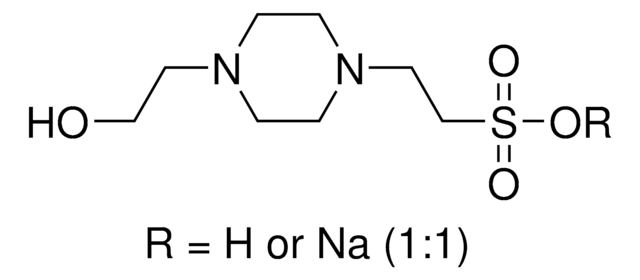391340
HEPES
≥99% (alkalimetric), solid, pH 6.8-8.2, Molecular Biology
Synonym(s):
HEPES, N-2-Hydroxyethylpiperazine-Nʹ-2-ethanesulfonic Acid, 4-(2-Hydroxyethyl)piperazine-1-ethanesulfonic acid, N-(2-Hydroxyethyl)piperazine-N′-(2-ethanesulfonic acid)
About This Item
Recommended Products
Product Name
HEPES, Free Acid, Molecular Biology Grade, A zwitterionice N-substituted aminosulfonic acid buffer. Useful in the pH 6.8-8.2 range. Has a pKa of 7.48 at 25°C.
grade
Molecular Biology
Quality Level
description
Merck USA index - 14, 4654
Assay
≥99% (alkalimetric)
form
solid
manufacturer/tradename
Calbiochem®
storage condition
OK to freeze
color
white
useful pH range
6.8-8.2
pKa (25 °C)
7.5
solubility
water: 400 mg/mL
aqueous base: soluble
cation traces
heavy metals: ≤0.0005%
foreign activity
DNase, RNase, and protease, none detected
shipped in
ambient
storage temp.
15-25°C
SMILES string
OCCN1CCN(CC1)CCS(O)(=O)=O
InChI
1S/C8H18N2O4S/c11-7-5-9-1-3-10(4-2-9)6-8-15(12,13)14/h11H,1-8H2,(H,12,13,14)
InChI key
JKMHFZQWWAIEOD-UHFFFAOYSA-N
Looking for similar products? Visit Product Comparison Guide
General description
Application
- Fluorescent labeling of the root cap cells with the bioactive NBD-S chemical probe based on the cellulose biosynthesis inhibition herbicides: This innovative study demonstrates the application of molecular biology grade HEPES in the formulation of bioactive probes for the fluorescent labeling of root cap cells. Using cellulose biosynthesis inhibition herbicides as a model system, this research provides valuable insights into plant biology, aiding in the understanding of plant cell wall structures and functions. The use of HEPES helps maintain the physiological pH during the experiments, ensuring the stability and effectiveness of the chemical probes used (Tamogami S et al., 2021).
Warning
Legal Information
Storage Class Code
13 - Non Combustible Solids
WGK
WGK 1
Flash Point(F)
Not applicable
Flash Point(C)
Not applicable
Certificates of Analysis (COA)
Search for Certificates of Analysis (COA) by entering the products Lot/Batch Number. Lot and Batch Numbers can be found on a product’s label following the words ‘Lot’ or ‘Batch’.
Already Own This Product?
Find documentation for the products that you have recently purchased in the Document Library.
Customers Also Viewed
Our team of scientists has experience in all areas of research including Life Science, Material Science, Chemical Synthesis, Chromatography, Analytical and many others.
Contact Technical Service


